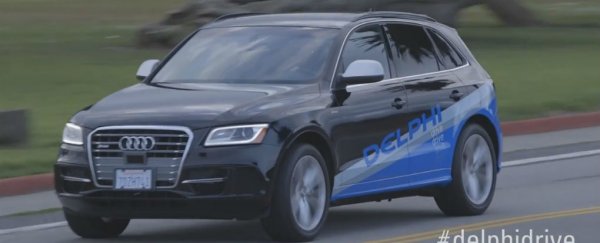Imagine a road trip where you don't ever need to watch the road, or where arguments with your sidekick about missed turn-offs never materialise. It kind of takes some of the fun out of it, really.
Until you realise that, instead of staring at concrete, you can kick back and play cards with friends, sleep to your heart's content, work on that novel you've been putting off, or simply take in all the breathtaking scenery.
Well, my friends, the future of driverless road trips has arrived - whether you like it or not.
A self-driving car has embarked on an eight-day, 5,600-kilometre (3,500-mile) road trip across the continental United States. The journey began at the Golden Gate Bridge in San Francisco, and the car is now en route to New York City, where it's scheduled to arrive just in time for the Big Apple's international auto show on April 3rd. You can follow the epic journey on Twitter.
And the human passengers along for the ride?
Well, presumably they can sit back, relax, and pray that the car's artificial intelligence doesn't drive them into oncoming traffic.
Luckily, the technology is becoming more reliable. Hundreds of thousands of kilometres have been logged in self-driving cars, demonstrated by the likes of Google or any number of conventional car manufacturers. And we're even starting to see some super-sleek robotic cars, like this Mercedes Benz demo spotted earlier this month.
But this latest vehicle hasn't been developed by a car company. Rather, it's the brainchild of an outfit called Delphi Automotive, which develops technologies for automotive components.
And according to Alex Davies at WIRED, Delphi has a solid record of innovation over more than a century: "It built the first electric starter in 1911, the first in-dash car radio in 1936, and the first integrated radio-navi system in 1994."
But increasingly, the components it's being tasked with delivering are geared toward automation - specifically, driverless automation.
The company has already done a good job at adapting. As Jeremy Hsu points out for IEEE Spectrum, "the company made $1.4 billion in 2014 from selling technologies such as active safety features that automatically keep cars from drifting across lanes or that brake faster than humans can react."
To continue to stay ahead of the curve, it decided to build its own automated car, kitting-out a 2014 Audi SQ5 with sensors and computers that can replace human drivers - at least on highways.
For instance, a camera in the windscreen looks for lane lines, road signs and traffic lights. While several different-range radar systems help the vehicle detect and track nearby objects, such as passing cars or bicycles, in order to keep a safe distance or activate braking if necessary.
Delphi isn't planning on breaking into the retail car scene, but rather, wants to develop innovative hardware components and software that automated cars will increasingly need.
"What we expect to do is be able to create better sensors and more sensors, and then the software algorithms as well, which the [automakers] will need as they take more steps along that journey to automated driving," Delphi CTO Jeff Owens told Alex Davies at WIRED.
The cross-country roadtrip will deliver terabytes of information on how the vehicle's sensors detect the world around it. The team hopes that this data can be used to improve the components in the car, and the algorithms, to ultimately make the system more robust and reliable.
The car will drive eight hours per day, for eight days. And while human drivers will intermittently need to take over the reigns off-highway, the trip will more or less be sans driver.
Oh, the memories. I wonder if the car will get upset when one of the passengers needs a pee break?
Sources: IEEE Spectrum, WIRED
